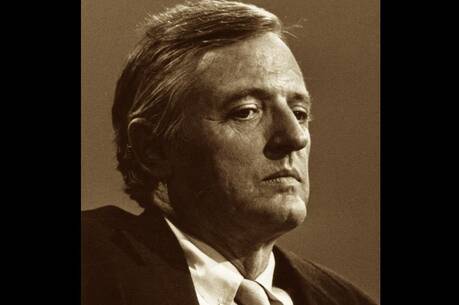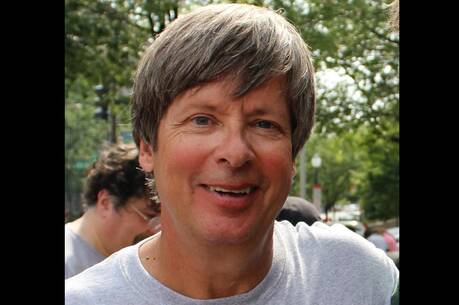A Movable Feast
Notre Dame is a world unto itself - a place apart. Unlike Georgetown University or Boston College, where students can get away from campus and wash off their school colors in the secular currents of Wisconsin Avenue or Commonwealth Avenue for a day or a night (every night if they want), Notre Dame students are virtually in the shadow of the Golden Dome wherever they go in South Bend. Fordham University students can intern a couple of afternoons a week at Morgan Stanley or Conde Nast (or even at America) and stay in the city late to see whatever band is playing downtown at Irving Plaza. Even students at John Carroll University easily go off to Jacobs Field or the Cleveland Museum of Art or to see LeBron James play with the Cavaliers. But in South Bend, Ind., the biggest ball field and the biggest art collection and the biggest jocks in townnot to mention the biggest band and the biggest Jesusare all right there on campus, just as they were a generation ago.
With this on-campus-ness, this ongoing-ness, this near-isolation from the tangible world of commerce (Chicago being a long 90 miles away), there are not many examples of worldly success for the studentsexcept for the increasingly upper-middle class parents, when they visit for the all-important games. (Parents of students in Boston or Washington would have other reasons to visit.) At Notre Dame, then, there is a sense of place and a reliance on one another that is intense, inward-looking and essential to the spirit of the school. It must be more than coincidence that the most frequented place on campus has its name for reasons beyond the obvious. The student hangout is called The Huddle.
To say Jim and Jeremy Langford, father and son, know all this is an understatement. Not only did they graduate from Notre Dame, but their father/grandfather, Walter, did as well. In fact, Walter stayed on at the school and worked as a professor, coach and campus Peace Corps director. So Jim the son grew up in the Dome’s shadow and then stayed on himself for 15 years, and Jeremy grew up in Sound Bend. The Lowells of Boston have nothing on these Langfords when it comes to institutional tradition. So who better to write a book about the place and call it, what else, The Spirit of Notre Dame?
Regis Philbin (class of ’53) has written a foreword. The Langfords recruited many other contributors as well. Their book is one of those cubist takes on a place. As a compilation of viewpoints and memories, it reads like a Studs Terkel oral history. We hear many voices from different erassome archival, some current. And this seems the perfect approach to take for such a book. There are no long chapters reporting in detail Father Sorin’s arrival from France by boat and how many people died in the crossing. The Langfords avoid any Michener-like delving into the history of gold mining to explain the brilliance of the sun shining on the Dome on game day.
This is a book of voices, voices of people who went to Notre Dame or worked there or felt for the place in some special way, even if they did not go there. There are memories of old professors, and former jocks, and students who were inspired by the place. There’s Edward A. Malloy, C.S.C., known as Monk, the recently retired university president, and John I. Jenkins, C.S.C., the new president, as well as Theodore Hesburgh, C.S.C., who had presided over Walter’s funeral Mass. As president for 35 years, Hesburgh watched over and fostered the further growth of Notre Dame. For most of those years, the light would remain on in his office inside the administration building (the Dome) until the wee hours, warm against the empty Indiana night. Many a student stopped in to see him. And those same students were surely coaxed more than once later by their parents to tell the tale of that night when Father Hesburgh made time to see them. Such is the stuff of legends and spirit and huddling, if you will, that make Notre Dame a movable feast for so many. Among many other voices heard from are Red Smith and Ronald Reagan and the late, much-loved English professor Frank O’Malley.
The Spirit of Notre Dame is not only for Notre Dame alums, any more than Rudy is a movie for Domers alone. It’s not even just for Catholics. It is a book about an American place that must mean enough to the country to have the only college football team whose every game is broadcast on national television.
As many will recall, there are daysmany daysin the late fall when it starts to get cold and wet in South Bend and you keep your head down while crossing the quiet campus at night, maybe on the way back from another dorm or The Huddle or on the way to the library. It is so harsh out that you don’t notice the big Jesus on the library or, if this was your era, even notice that Hesburgh’s light is on. You mutter to yourself about how your friends at other schools are warmer, have more to do. You think of transferring, going where brighter lights are. Then from a far corner of the campus by the stadium you hear it: the band is finishing up practice over by that House That Rockne Built and it’s coming your way in the dark. It’s the Victory March they are playing and it’s coming right toward you, getting louder. There is no one near you, and suddenly you’re a kid again. You walk faster and you’re not cold anymore. Your spirit is changed. Everything you want is right there.
The Langfords know that feeling.
This article also appeared in print, under the headline “A Movable Feast,” in the October 10, 2005, issue.








